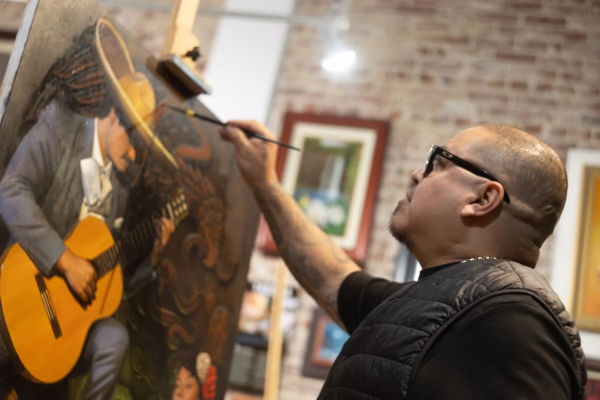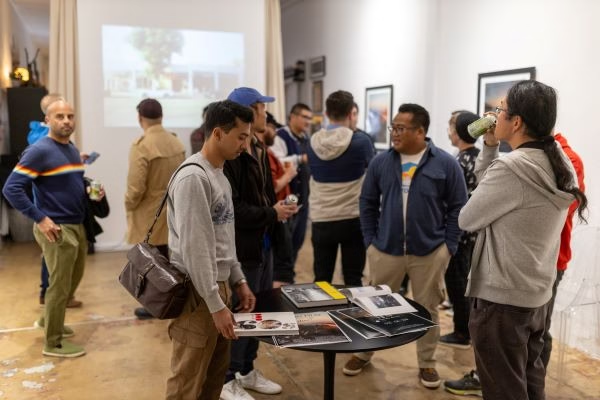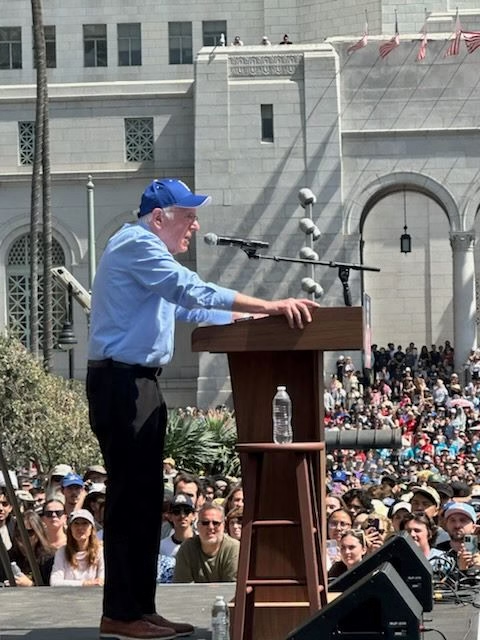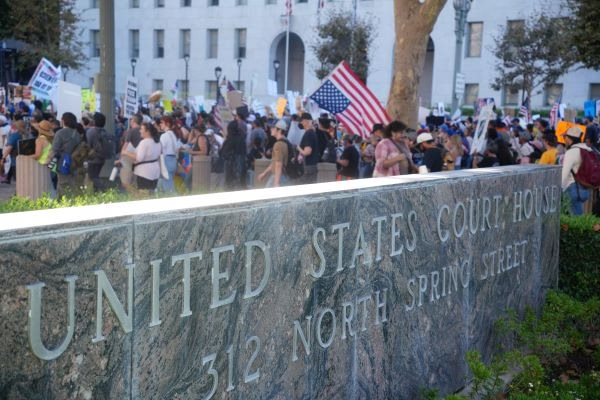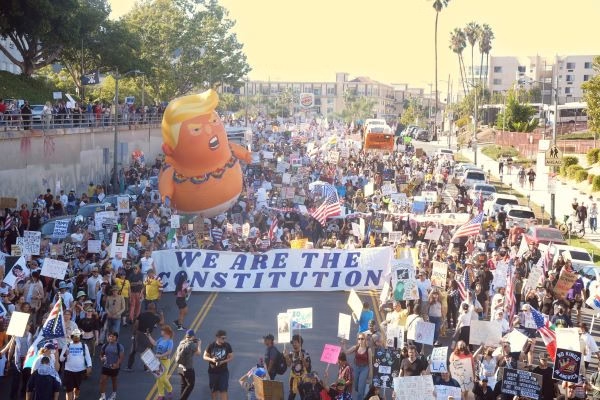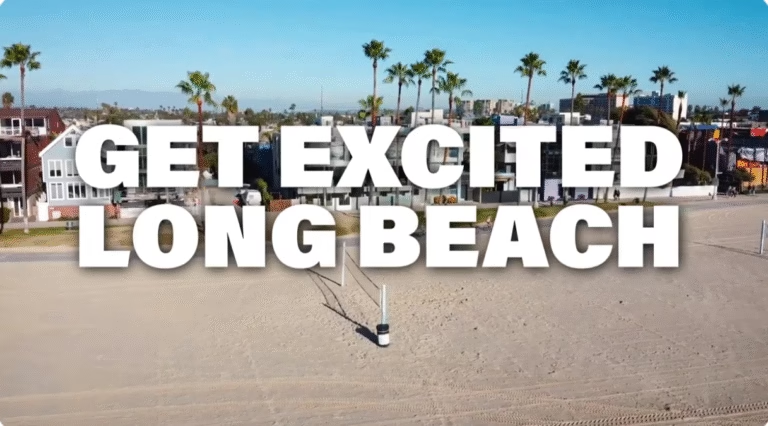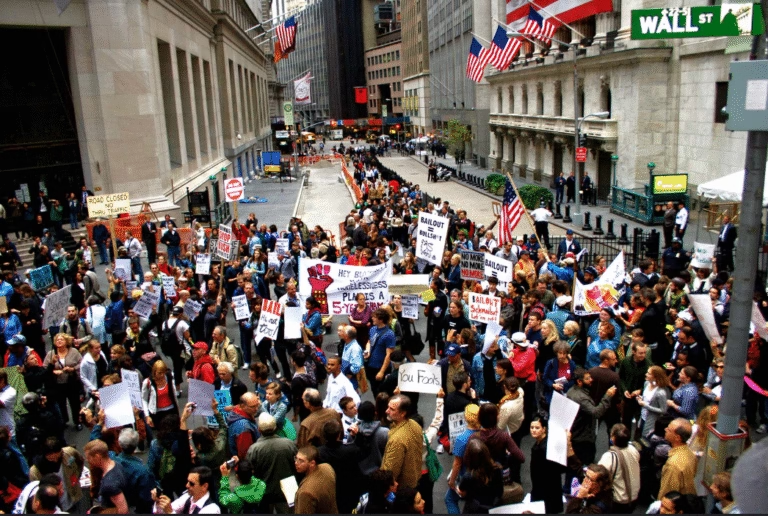Seven million people turned out in a patriotic protest of Trump’s ongoing attempt to subvert American democracy on Oct. 18. It was by far the largest such demonstration ever, 10 times larger than the Tea Party at its peak and 2 million more than the first No Kings demonstration in June.
Inspired by the example of Portland, there was a widespread playful presence of inflatable costumes, mocking the president’s ludicrous attempts to portray the demonstrations as a menacing threat to the republic.
“Fun and play are often a part of social movements as the people trust the larger group to hold their values as the conflict with the state expands,” social movement scholar Dr. Lisa Corrigan explained on Bluesky. “When the conflict expands in scale & scope, the good feelings help propel people to do hard things,” she added.
A unicorn-clad protester in LA told MSNBC’s Jacob Soboroff, “We’re here peacefully protesting, looking as ridiculous as we can, just so maybe we appeal to the president, because he’s a ridiculous leader that is normalizing abuse of power. And we cannot stand and act like nothing is happening.”
“Why the costumes?” historian Joanne Freeman asked on Bluesky. “Authoritarians grab power with fear. They can’t STAND mockery. It weakens their hold. That’s why.”
And Trump’s hold was weakened, dramatically. He responded to the protests that night with infantile rage on his social media platform in the form of an AI-generated video showing him wearing a crown and flying a fighter plane over a crowd of protesters whom he showered with shit. In a normally-functioning democracy, he would be out of office by the time you read this. But we are not a normally-functioning democracy.
That’s the whole point of No Kings protests and movement. Sustained non-violent protest movements have a high (though not perfect) rate of success in ousting strongmen once they reach a threshold of around 3.5% of the population (about 11 million Americans), so the No King movement is more than halfway there in nine months time. Which raises the question of what comes next.
Leah Greenberg, co-founder of Indivisible, a principal No Kings backer, gave a two-fold answer the morning afterwards on MSNBC. “If this is your first protest, find your organizing home. That could be an Indivisible group, that could be a 50501 group, that could be another local organizing hub,” the point is to find people in your community to take effective action with.
Second, she said, would be the fruit of a follow-up organizing call, “to collectively come together and make sure that people are taking action on a regular basis to push back on the enablers of Trump and MAGA,” she said. “This is not just about one man. This might be no kings, but there’s an entire court that is holding him up, and we actually have to apply our collective power to mobilizing but also to pushing those folks.”
We’ve already seen examples of how this can work, with the swift reinstatement of Jimmy Kimmel as a prime example. Another example is the recent refusal of colleges, including USC, to agree to the Trump administration “compact” that would destroy the fundamental framework of academic freedom.
When Trump was inaugurated, a lot of powerful people thought he was going to consolidate power, and they decided to go along, Greenberg noted. “What we are doing is we are bringing together millions and millions and millions of people, more every single time we come out to say ‘Oh no! He is not going to. He is actually facing a bigger and growing and rising force all over this country that is going to push back on him, and you better factor that into your own decisions — if you’re a corporation, if you’re a university, if you are making a decision about whether you’re going along with Donald Trump or whether you’re pushing back, you’ve got to understand that we are out there, and we are watching.”
So we should expect to see some striking developments in how the No Kings movement expands on these sorts of battles going forward.
Meanwhile, local leaders with two Indivisible chapters offered Random Lengths some follow-up suggestions of the first sort even before No Kings Day. “I would encourage people to get involved in any way they can,” said Kenny Johnson with South Bay Indivisible. “People’s passions and talents are needed everywhere to push back against the authoritarianism from the Trump administration and the Republican Party.”
“There’s a lot of fear, anger, and despair over everything that’s happening, and the best way to counteract that is with courage, love, and hope,” said Heather Rodriguez of Lakewood Indivisible. “Instead of witnessing terrible things happening in isolation, I encourage everyone to come together and be comforted in the fact that you are not helpless; in fact you are joining in important work to help your community, and there are others like you right here who will help you too.”
First, she said, “We will be doing a Disappeared in America candlelight vigil on Oct. 28 by our Lakewood city council chambers during the city council meeting to bring awareness to people kidnapped by ICE within our city. We would love people to attend and have invited all of our local representatives.”
In addition, “We are suggesting people support street vendors by buying from them. We collected donations to buy a bunch of flowers from a local flower vendor for tomorrow’s protest,” she said. “Donating food or clothing to mutual aid programs is so helpful. Our group has seen a huge increase in local need. Many established mutual aid groups are so overwhelmed, they refer people to more grassroots groups in hopes that we can get supplies and help faster. It’s insane. Some of us are putting home gardens to use in getting healthy donations as well.”
There are also organized options. “Join a local rapid response or ICE patrol group,” she suggested. “Our volunteers make contact with day laborers, car wash employees, and other at-risk people and maintain a visible presence to deter ICE, get resources to people who need them, record ICE interactions, etc.”
Putting it all together, she said, “We have built this network of helpers and it’s beautiful. Please come and be a part of it with us.”
Johnson struck some similar themes, suggesting joining community self defense groups “like Union del Barrio, Harbor Area Peace Patrols, or others to help keep your neighbors safe from ICE and DHS,” as well as joining an ICE rapid response network, with groups like CHIRLA and Orale. He also suggested people “Join a mutual aid organization, tenants union, or other groups that are seeking to provide aid and protection to our most vulnerable communities.”
But there are also political actions to consider. With the November election just weeks away, the most urgent thing Johnson mentioned was canvassing, phone-banking or text-banking for Prop 50, the ‘Election Rigging Response Act,’ to help offset the GOP redistricting efforts Trump has been pushing, starting in Texas. “It’s critical that Democrats take back the House in 2026,” Johnson said.
In addition, he suggested, “Join your local Indivisible, DSA, Working Families Party, or Democratic club. We’ll need all hands on deck for 2026 to get Democrats and (preferably) progressives elected — especially those willing to fight back.”
But don’t just work to elect folks. “Demand more from your elected officials,” he said. “Call them, email them, show up to town halls, city council meetings, etc.”
And he also advised running for local office, countering what MAGA Republicans have done in running for school boards, library commissions and city councils. Run For Something has a well-developed support system for potential candidates, and Local Progress has support for advancing progressive policy once folks are elected.
There are, in short, a wide range of different things people can do. “No one can do everything, but everyone can do something,” political scientist Nathan Kalmoe wrote on Bluesky. It’s a saying whose origins are uncertain, but “It’s a super important concept,” he said. “Empowering, with the bonus of being true. Problems feel overwhelming until we can see how a little bit from all of us adds up to make big changes.”
In addition, “It also emphasizes that change requires many types of contributions. People think doing politics is voting, posting on social media, and maybe protesting/donating. But it’s also civics lessons, and legal briefs, and healthcare guided by awareness of discrimination, and sermons centering empathy and care, and helping a neighbor or family member understand why it matters to them, and equitable hiring practices in business and workplace organizing.”
Seen in this expansive framework, the question becomes one of how to make the most of what people are already doing alongside what more they might do. Organizer and author Stacey Abrams provides a multi-level model for this in her podcast, “Some Assembly Required.” On the micro level, Abrams provides a framework for individuals to integrate what they’re already doing with something more, while on the macro level she provides a framework for doing the same collectively.
The micro level framework is laid out in every episode. While Abrams discusses a wide range of salient political issues with one or more knowledgeable experts, she routinely closes with a three-part “toolkit”: First, be curious (find more information to better informed); second, take action (do something concrete to advance policy change); and third, do good (provide specific help). For example, on her Sept. 11 episode, she explored Trump’s attacks on public education. The toolkit for that episode was:
- BE CURIOUS: To learn how the right wing’s attacks on public education have misled policymakers and parents, read Death and the Life of the Great American School System: How Testing and Choice Are Undermining Education by Diane Ravitch.
- SOLVE PROBLEMS: Protecting education is a job for all of us. Attend a school board meeting where you live before December to learn about what’s happening in your community’s schools. Don’t assume everyone knows what’s going on — talk to your neighbors about the issues you care about most. And empower your older children to join you in these efforts.
- DO GOOD: With cuts to SNAP, many children will not have access to regular meals. Consider joining up with neighbors to put together weekend food backpacks for kids. Visit www.feedingamerica.org and search “backpack program” for more information.
Then at the macro level, Abrams provides another model. In her work, she uses the “Ten Steps to Autocracy” framework inspired by Princeton Professor Kim Scheppele, which begins with step one: “The powerful are chosen in a free and fair election, but it’s likely the last one,” and concludes with step 10: “They end democracy itself by disrupting elections, undermining voting systems, and formalizing authoritarian rule.”
In her Sept. 18 episode, she introduced a contrasting framework, “Ten Steps to Freedom and Power,” articulated as action verbs. “In every nation that has faced this fight and reclaimed democracy,” she said, “the Ten Steps are these: commit, share, organize, mobilize, litigate, disrupt, deny, engage, elect, and demand. In total, the Ten Steps campaign is about how we realize we are not alone and that we can win. We can save ourselves. Like one of those photo mosaics, each of us is part of the larger picture. Even though we feel very small. Yes, we may feel overmatched and like we’ve already fallen too far behind. But victories have been won with less.”
This echoes what Kalmoe was saying about the many different types of contributions, and the recognition that “everyone can do something.” But one other thing that Abrams said is crucial:
“The time for absolute agreement is over. Now is the time to get to work with whomever is willing to work with us. We don’t have to do the same things in the same way or for the same reason, but we all have to take action now.”






